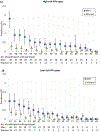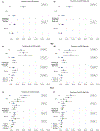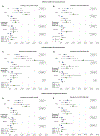Oral Human Papillomavirus Infection: Differences in Prevalence Between Sexes and Concordance With Genital Human Papillomavirus Infection, NHANES 2011 to 2014
- PMID: 29049523
- PMCID: PMC6203692
- DOI: 10.7326/M17-1363
Oral Human Papillomavirus Infection: Differences in Prevalence Between Sexes and Concordance With Genital Human Papillomavirus Infection, NHANES 2011 to 2014
Abstract
Background: The burden of human papillomavirus (HPV)-positive oropharyngeal squamous cell carcinoma (OPSCC) is disproportionately high among men, yet empirical evidence regarding the difference in prevalence of oral HPV infection between men and women is limited. Concordance of oral and genital HPV infection among men is unknown.
Objective: To determine the prevalence of oral HPV infection, as well as the concordance of oral and genital HPV infection, among U.S. men and women.
Design: Nationally representative survey.
Setting: Civilian noninstitutionalized population.
Participants: Adults aged 18 to 69 years from NHANES (National Health and Nutrition Examination Survey), 2011 to 2014.
Measurements: Oral rinse, penile swab, and vaginal swab specimens were evaluated by polymerase chain reaction followed by type-specific hybridization.
Results: The overall prevalence of oral HPV infection was 11.5% (95% CI, 9.8% to 13.1%) in men and 3.2% (CI, 2.7% to 3.8%) in women (equating to 11 million men and 3.2 million women nationwide). High-risk oral HPV infection was more prevalent among men (7.3% [CI, 6.0% to 8.6%]) than women (1.4% [CI, 1.0% to 1.8%]). Oral HPV 16 was 6 times more common in men (1.8% [CI, 1.3% to 2.2%]) than women (0.3% [CI, 0.1% to 0.5%]) (1.7 million men vs. 0.27 million women). Among men and women who reported having same-sex partners, the prevalence of high-risk HPV infection was 12.7% (CI, 7.0% to 18.4%) and 3.6% (CI, 1.4% to 5.9%), respectively. Among men who reported having 2 or more same-sex oral sex partners, the prevalence of high-risk HPV infection was 22.2% (CI, 9.6% to 34.8%). Oral HPV prevalence among men with concurrent genital HPV infection was 4-fold greater (19.3%) than among those without it (4.4%). Men had 5.4% (CI, 5.1% to 5.8%) greater predicted probability of high-risk oral HPV infection than women. The predicted probability of high-risk oral HPV infection was greatest among black participants, those who smoked more than 20 cigarettes daily, current marijuana users, and those who reported 16 or more lifetime vaginal or oral sex partners.
Limitation: Sexual behaviors were self-reported.
Conclusion: Oral HPV infection is common among U.S. men. This study's findings provide several policy implications to guide future OPSCC prevention efforts to combat this disease.
Primary funding source: National Cancer Institute.
Conflict of interest statement
Potential conflict of interest disclosures: Dr. Wilkin has received grant support paid to Weill Cornell Medicine from Bristol-Myers Squibb, Gilead Sciences, GlaxoSmithKline/Viiv Healthcare. Dr. Wilkin has served as an ad hoc consultant to GlaxoSmithKline/ViiV Healthcare. Dr. Sikora receives unrestricted research funding from Advaxis in support of an investigator-initiated trial of a therapeutic vaccine for HPV-related head and neck cancer. Dr. Chhatwal received grant support from Gilead and consulting fee from Gilead and Merck on unrelated projects.
Figures



Comment in
-
Unraveling the Epidemiology of Oral Human Papillomavirus Infection.Ann Intern Med. 2017 Nov 21;167(10):748-749. doi: 10.7326/M17-2628. Epub 2017 Oct 17. Ann Intern Med. 2017. PMID: 29049824 No abstract available.
Similar articles
-
Prevalence of oral HPV infection in the United States, 2009-2010.JAMA. 2012 Feb 15;307(7):693-703. doi: 10.1001/jama.2012.101. Epub 2012 Jan 26. JAMA. 2012. PMID: 22282321 Free PMC article.
-
NHANES 2009-2012 Findings: Association of Sexual Behaviors with Higher Prevalence of Oral Oncogenic Human Papillomavirus Infections in U.S. Men.Cancer Res. 2015 Jun 15;75(12):2468-77. doi: 10.1158/0008-5472.CAN-14-2843. Epub 2015 Apr 14. Cancer Res. 2015. PMID: 25873485 Free PMC article.
-
Barrier use during oro-genital sex and oral Human Papillomavirus prevalence: Analysis of NHANES 2009-2014.Oral Dis. 2019 Mar;25(2):609-616. doi: 10.1111/odi.12997. Epub 2018 Nov 25. Oral Dis. 2019. PMID: 30367525
-
National prevalence of oral HPV infection and related risk factors in the U.S. adult population.Oral Dis. 2012 Jul;18(5):430-41. doi: 10.1111/j.1601-0825.2011.01892.x. Epub 2012 Jan 18. Oral Dis. 2012. PMID: 22251072 Review.
-
Human papillomavirus infection and associated disease in persons infected with human immunodeficiency virus.Clin Infect Dis. 1995 Aug;21 Suppl 1:S121-4. doi: 10.1093/clinids/21.supplement_1.s121. Clin Infect Dis. 1995. PMID: 8547501 Review.
Cited by
-
New Insights into Oral Cancer-Risk Factors and Prevention: A Review of Literature.Int J Prev Med. 2020 Dec 30;11:202. doi: 10.4103/ijpvm.IJPVM_403_18. eCollection 2020. Int J Prev Med. 2020. PMID: 33815726 Free PMC article. Review.
-
State LGBTQ policy environments and the cancer burden in sexual and gender minoritized communities in the United States.Cancer Med. 2024 Aug;13(15):e70097. doi: 10.1002/cam4.70097. Cancer Med. 2024. PMID: 39140345 Free PMC article.
-
Analysis of Race and Gender Disparities in Mortality Trends from Patients Diagnosed with Nasopharyngeal, Oropharyngeal and Hypopharyngeal Cancer from 2000 to 2017.Int J Gen Med. 2021 Oct 2;14:6315-6323. doi: 10.2147/IJGM.S301837. eCollection 2021. Int J Gen Med. 2021. PMID: 34629896 Free PMC article.
-
Cannabinoids Promote Progression of HPV-Positive Head and Neck Squamous Cell Carcinoma via p38 MAPK Activation.Clin Cancer Res. 2020 Jun 1;26(11):2693-2703. doi: 10.1158/1078-0432.CCR-18-3301. Epub 2020 Jan 13. Clin Cancer Res. 2020. PMID: 31932491 Free PMC article.
-
Trends in Human Papillomavirus Vaccine Safety Concerns and Adverse Event Reporting in the United States.JAMA Netw Open. 2021 Sep 1;4(9):e2124502. doi: 10.1001/jamanetworkopen.2021.24502. JAMA Netw Open. 2021. PMID: 34533574 Free PMC article.
References
-
- Giuliano AR, Nyitray AG, Kreimer AR, Pierce Campbell CM, Goodman MT, Sudenga SL, et al. EUROGIN 2014 roadmap: differences in human papillomavirus infection natural history, transmission and human papillomavirus-related cancer incidence by gender and anatomic site of infection. Int J Cancer. 2015;136(12):2752–60. - PMC - PubMed
-
- Viens LJ, Henley SJ, Watson M, Markowitz LE, Thomas CC, Thompson TD, et al. Human Papillomavirus-Associated Cancers - United States, 2008–2012. MMWR Morb Mortal Wkly Rep 2016;65(26):661–6. - PubMed
MeSH terms
Grants and funding
LinkOut - more resources
Full Text Sources
Other Literature Sources
Medical
